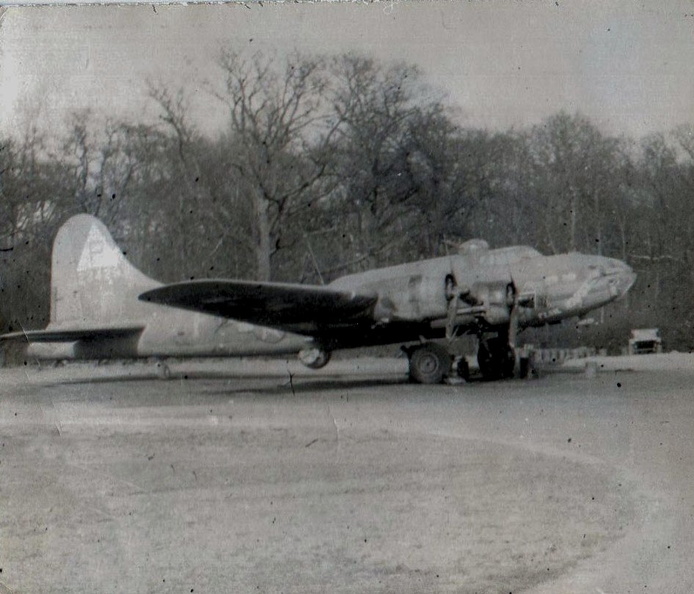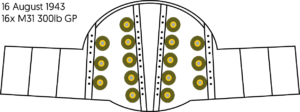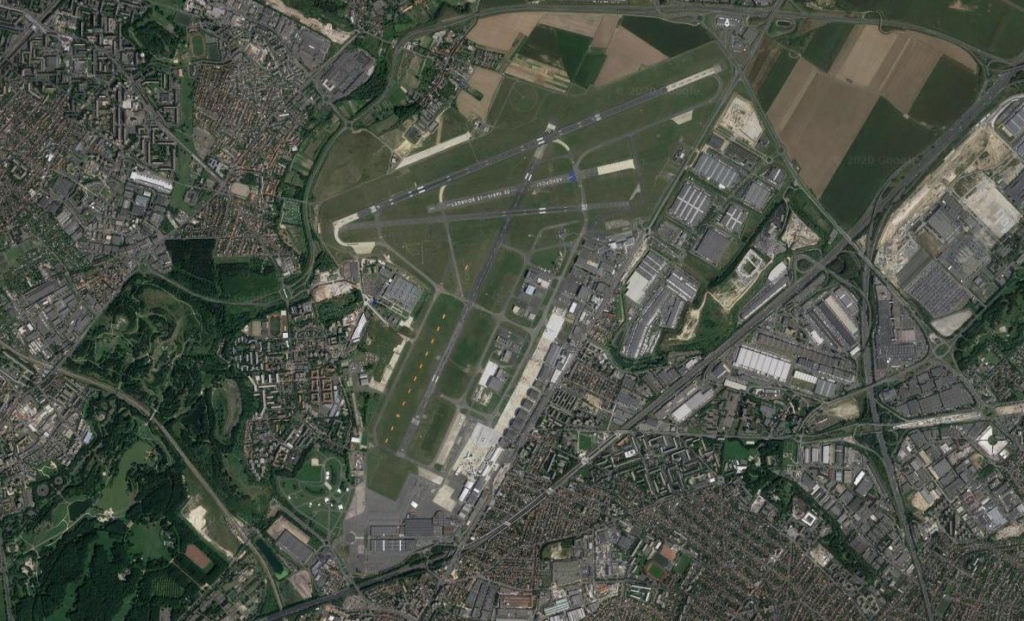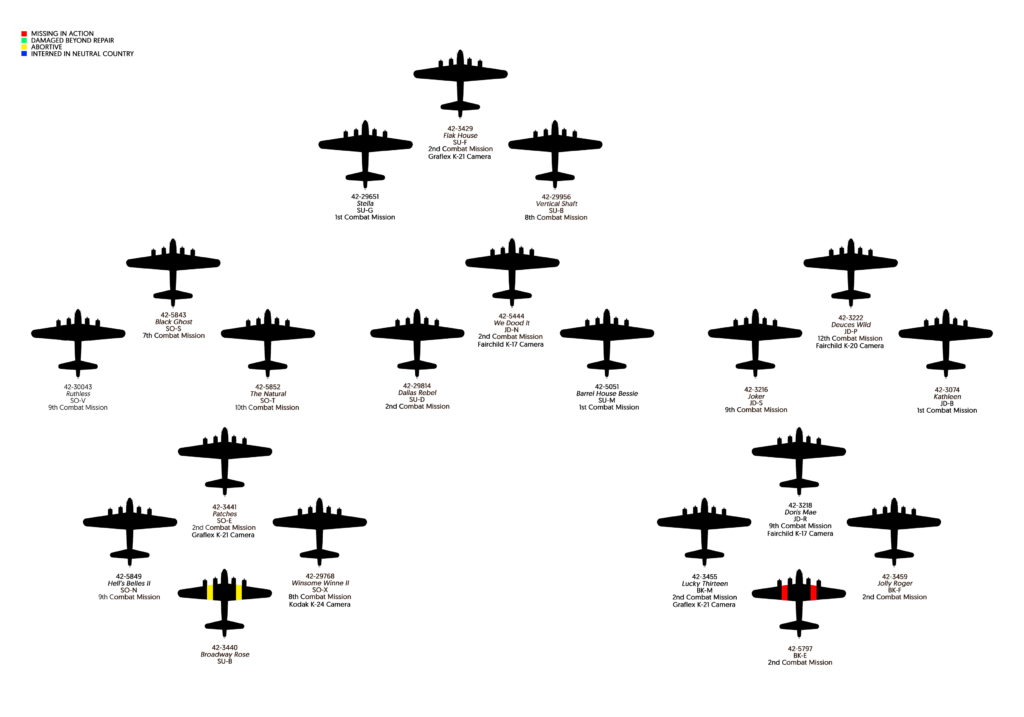77 years ago today, Lucky Thirteen flew her second combat mission.
16 August 1943
VIII BC No. 83
Ramrod 203
384BG No. 16
The US 8AF launches 246 Boeing B-17s, escorted by 180 Republic P-47s with 75 gal belly tanks, against the airfields of Abbeville, Paris–Le Bourget, and Poé-d’Picardie, France. Additional escort is provided by RAF 11 Group. The 384BG launches twenty aircraft this day, the group being led by XO 384BG MAJ Thomas P. Beckett aboard Flak House (42-3429). Lucky Thirteen flies in the high squadron as the second element third.
Once again, this strike is part of Operation STARKEY, itself the aerial component of Operation COCKADE. COCKADE had been bitterly resisted by the Allied air and naval services, claiming that it was a wasteful allocation of resources better spent elsewhere. In retrospect, it seems they were right. The Wehrmacht largely ignored the operations around Calais, rightfully concluding that the haphazard nature of the attacks indicated a ruse. This was particularly the case with the Luftwaffe, who would not attack the bomber formations in force knowing that the strikes were within range of fighter escort.
The 384BG’s aircraft are loaded with 16 AN-M31 300lb GP bombs each, their primary target being the massive Paris–Le Bourget air complex. Approximately 50 enemy fighters are encountered en route, with at least one attack being made four-abreast from behind. Aside from a single loss, the 384BG’s strike is made exactly as planned.
Aboard Lucky Thirteen, top turret gunner TSGT Oscar K. Hamblin and tail gunner SSGT William H. Ross are credited with a probable kill. The FW-190 approached from 7 o’clock, apparently heading for the lead squadron while on the bomb run. At interrogation her crew also complained about the suit and intercom lines in the waist becoming entangled – an understandable problem.
The numbers:
| Bombers Launched: | 246 |
| Bombers Effective: | 237 |
| Fighters Launched: | 180 |
| Bombers MIA: | 4 |
| Bombers Abort: | 9 |
| Fighters MIA: | 3 |
| Fighters DBR: | 2 |
| Abort Rate: | 4% |
| Loss Rate: | 2% |
| E/A Destroyed: | 17 |
*Please note that the numbers above come from official US and German sources as victory claims cannot be relied upon. The numbers above do not account for RAF statistics.

The 384BG’s lead bomber on this strike: Flak House (42-3429).
This aircraft completed 21 combat missions before retired from active duty in May 1944. By that time, she was one of the last F-models still in frontline service.
It is also worth noting that, like Lucky Thirteen, Flak House was a Douglas-built late F-model.
The 384BG’s formation chart from this day.
Broadway Rose (42-3440) aborts due to her No. 2 engine throwing oil and smoking, necessitating a feathered prop. She returns with her bombload intact.
“E for Easy” (42-5797) is shot down shortly after the bomb run, her right wing catching fire. Nine bail out, with two successfully evading capture. Her tail gunner, SSGT James B. Murray, is killed in action.

The standard US bomb design was later altered to have a pair of lugs on one side and a single lug on the other. This allowed for a greater variety of aircraft types capable of carrying US bombs. When this change occurred, the 300 lb type shown here, the M31, was phased out of service and replaced by the M57 250 lb bomb.
The 300 lb bomb was an awkward size and one bomber from this day’s strike, Barrel House Bessie (42-5051), returned with a bomb still aboard due to it having been improperly mounted.

The 384BG’s strike route for 16 August 1943. The target was bombed at an altitude of 19,000 ft. Average temperature was -10 degrees.
All times in AM.
| Engine Start: | 6:40 |
| Taxi: | 6:55 |
| Takeoff: | 7:10 |
| Feet Wet: | 8:48 |
| Feet Dry: | 9:05 |
| IP: | 9:26 |
| Target I: | 9:32 |
| Feet Wet: | 10:24 |
| Home: | 11:36 |

A Ju-88 hangar at Le Bourget that was destroyed on 16 August 1943.
The Paris-Le Bourget airfield was repurposed after the war as the city’s principal civilian airport. It remains one of the largest in Europe.

The Paris-Le Bourget Airport as it appears today.
This photo was taken facing north. The attack of 16 August 1943 was made at 133 degrees, which roughly translates as a downward slant from left to right.

The suburb of Dugny, which sits at the south end of the Paris-Le Bourget airfield, suffered heavily from this day’s strike.

This day is noteworthy as seeing the last usage of the YB-40 escort gunship.
A subject often misunderstood, the YB-40 was never intended to replace fighter escort – it was a stopgap. When war broke out in Europe, the US implemented a crash program to extend fighter range and arm its bombers with powered gun turrets. The latter issue was solved with greater speed and the Air War Plans Division suggested using gunship escorts until long-range fighter escort fighters became available. With pressurized droptanks now entering service, the YB-40 is no longer needed. Some 25 YB-40s are built, taking part in 14 strikes before being retired. Only a single YB-40, Wango Wango (42-5735, 92BG) is ever lost to enemy action, being shot down over Hüls, Germany on 22 June 1943.
While popular historians generally dismiss the YB-40 as a failure, claiming it was too heavy to stay with its wards after bomb release, 92BG reports actually show that the YB-40 suffered no loss of performance whatsoever.
The most important contribution of the YB-40 program is that it saw the introduction of the Bendix chin turret. Developed from the A-5 belly turret used on the North American B-25, the new A-16 is standardized on the new B-17G series. Fittingly, the first flight of the B-17G occurs on this day.

